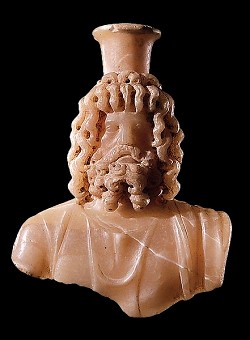
Scholars are undecided about the precise origin and meaning of Sarapis (or Serapis as he was called by the Roman emperors). Attempts have been made to demonstrate an origin in Asia Minor, Babylon or Greece, but so far unsuccessfully. It is more likely that Sarapis was 'born' on Egyptian soil. According to an ancient cult legend, Ptolemy I received orders in a dream to transport the cult statue of Pluto from Sinope on the Black Sea to Egypt. When he asked his advisors what the dream meant, they told him that the god was called Sarapis and that the order had to be followed, which it subsequently was. Some researchers interpret the story to mean that Sarapis was a deliberate creation of Ptolemy and his advisors with the intention of uniting the Egyptians and the Greeks living in Egypt under one religion. Others are of the opinion that the intention was to give the Greeks their own deity. There are two arguments against the theory that Sarapis was a Ptolemaic 'invention' - first, this would mean that for the first time in the history of religions an 'invented' deity was worshipped for a long time, and second, the legend demonstrates that the name Sarapis was already known to the advisors. It is clear that the name Sarapis is a graecized form of the name Osiris-Apis, the bull of Memphis identified with the ba of Osiris and worshipped in Egypt. The fact that the statue of Pluto in Alexandria was given the name Sarapis means that this new god was added to the pantheon as a special form of Osiris-Apis. However, Sarapis is not identical to Osiris; thus it is still only Osiris with whom an Egyptian wants to be identified with after death. There are also striking iconographic differences - Sarapis is never depicted mummiform, but rather as a Greek god with beard and a kalathos on his head.
The basis of the Sarapis theology is supplied by Osiris as the god of the underworld and of fertility. Just like Osiris, Sarapis is linked with the earth and with regenerative power. The kalathos that Sarapis wears on his head points to his links with the earth and its fruits. Just like Osiris, Sarapis, too, was regarded as the lord of the Nile, but also of the sea; he rules the storms and rescues people in peril. Sarapis quickly came to be seen as a healer of all kinds of diseases and this characteristic certainly contributed to him being worshipped in a wider circle. To his aspect as healer he also added that of giver of oracles; in both instances Sarapis used a dream or a vision to appear to believers. Sarapis has a close relationship with Isis; together with her he was worshipped as 'soter', saviour. In the Roman Period, Sarapis became associated with Helios and became the 'Lord of Time' and god of all, and his cult spread through the region around the Mediterranean Sea. In the 2nd century AD, the church father Tertullian could still state that 'the whole earth now swears by Serapis', but by 391 AD the destruction of his temples in Alexandria and Canopus marked the end of the worship of Sarapis.